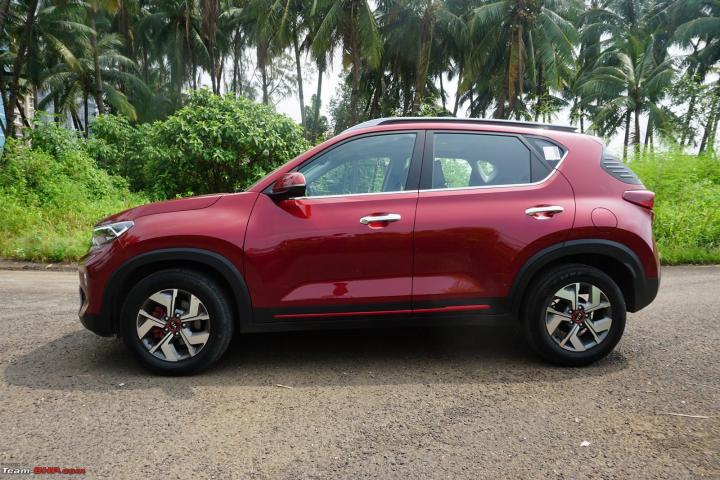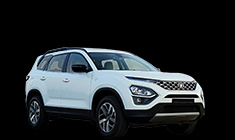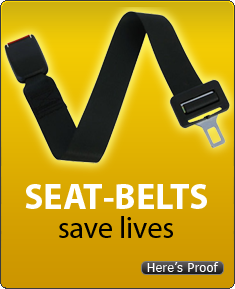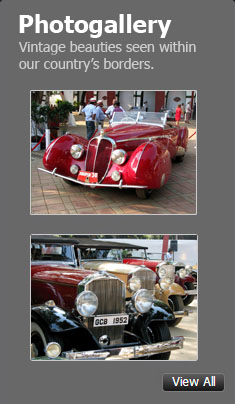News
New Kia Sonet 2020: 90 observations after 1 day of driving
The Kia Sonet was previewed by Team-BHP on August 7, 2020. Click here to read that detailed report!
Now, Aditya got to drive the 1.5L Diesel AT and 1.0L Turbo-Petrol iMT variants of the car for a day. Here are his observations.
• Kia's "top down" approach to India has proven effective. It's a bargain brand in many countries, but has a certain allure in India. Launching the fully-loaded Seltos & 35-lakh Carnival first, and then the Sonet has its benefits. Strategy wouldn't have been as effective the other way around (i.e. if the Sonet was launched first).
• The initial market response to the Kia Sonet has been good. Kia claims that it received 6,523 bookings for the car on the first day itself when bookings opened on August 20.
• The Sonet is a handsome car and looks like nothing else in the segment. It is easy to recognize as a Kia with the company’s signature “tiger nose” grille.
• Body cladding, roof rails, skid plates and flared wheel arches give this Compact SUV a rugged appearance.
• Chrome has been used around the foglamps, on the door handles and the window line. It’s only the application on the door handles that looks overdone & after-market-type.
• Like the Seltos & Creta, this is almost identical to the Venue under the skin.
• The car draws a lot of attention on the road. Car owners, bikers, pedestrians etc. all turned around to check out our test car. Some drivers and riders even changed course to get a closer look at it.
• Like the Seltos, the Sonet will be available in 2 variant categories – Tech Line and GT Line. Both categories will come in 3 variants - HTE / GTE, HTK / GTK and HTX / GTX, where E stands for Energy, K for Klass and X for eXtreme.
• GT Line gets red highlights on the grille, bumpers, body cladding and alloy wheels. Opinions about these are divided.
• The Sonet's wheels are the right size (16”). But the 215/60 section MRF Wanderer tyres lack grip & are typical...well, MRFs. We recommend an upgrade as soon as delivery of the car is taken.
• Ingress & egress are easy for all, including the elderly, thanks to the comparatively low floor and high roof.
• All-black interiors go well with the sporty external appearance of the Sonet. The cabin looks modern and with the times. Red contrast stitching lends a youthful look to the interiors.
• While black will be easier to live with and keep from getting soiled, a lighter shade would have given an airier feel. The all-black cabin feels tight. A dual-tone black & beige theme is available, but you have to opt for the Tech Line for that.
• All plastics used in the cabin are hard, yet of good quality. The leatherette inserts on the doorpads are the only soft material used.
• Piano black and silver inserts at various places give the dashboard a classy appearance.
• Ergonomics are spot on. Everything is exactly where it is expected to be and easy to reach. This is typical of Hyundais & now Kia.
• Cabin width is fair for a compact SUV and you won’t feel like you are sitting too close to the front passenger. It’s not quite as wide as the Tata Nexon though.
• Frontal visibility is good, but the C-pillars are thick, which hampers all-round visibility.
• Flat-bottom, leather steering with thumb contours has the right thickness and is a joy to hold. It comes with rake adjustment, but cannot be adjusted for reach. The Ford EcoSport remains the only sub-4 m crossover to offer that very-useful feature.
• Like I’ve observed in Hyundai–Kia cars, there are too many buttons on the steering wheel. There will be times when you press the wrong button.
• Digital speedometer gives an accurate reading, but the revv-counter is C-shaped and its difficult to tell the exact rpm. MID relays enough information and thankfully, analogue fuel and temperature gauges have been provided.
• Leather-wrapped gear shifter (with unlock button on the right) looks very upmarket.
• Pedals are well-positioned and the footwell is spacious. Dead pedal is useful.
• Driver’s seat has sufficient support. It gets height adjustment, but not lumbar adjustment. It’s got some bolstering on the sides, yet is sufficiently wide and even larger drivers should have no problem.
• Leatherette upholstery is of fine quality. Stitching is consistent. Ventilated front seats are a boon in the hot climatic conditions of India.
• Lots of storage spaces and cubby holes in the cabin. Apart from the regular cupholders and door pockets, you get umbrella holders on the front doorpads and a slot below the handbrake - between the two cupholders to store a smartphone or the car’s key fob. Even a sunglass holder is provided.
• Driver armrest is positioned too far behind. At 5’10”, I found it difficult to use. Shorter drivers will find it completely useless. It should have been extendable.
• Overall cabin space is decent. Two six-footers will be able to sit one behind the other without feeling cramped.
• Rear seat has a comfortable angle for the backrest. However, the seatbase is on the lower side. Taller users will find the under-thigh support inadequate. Besides, the seat is not wide enough for three adults to sit comfortably. More like 2 adults + a kid.
• Head room is more than adequate. The roofliner is higher where the rear passengers' heads will be.
• Prominent floor hump and rear air-con console will restrict space for the middle passenger.
• Powerful air-con chills the interiors in no time.
• Design of the air-con console is a love it / hate it affair.
• Sunroof is a very welcome feature. It is electrically operated with a manual cover and reasonably sized.
• Like the Seltos, the 10.25” touchscreen head-unit looks like an extension of the instrument cluster. It is responsive to use and has an easy-to-understand user interface.
• Sound quality from the 7-speaker Bose sound system is very good, but not exceptional.
• 392-liter boot is the largest among its competitors. It’s big enough for the driving holidays us BHPians love.
• The rear seat does not split. Hence, if you want to carry longer objects in the boot along with a third person, it will be difficult. This kind of sucks and IMHO, splitting seats in hatchbacks & crossovers should be mandatory.
• 1.5L diesel engine is refined and quick! It works beautifully with the 6-speed torque converter AT. This proper, smooth Diesel AT is a major USP in a sea of jerky Diesel AMTs.
• With controlled turbo lag, low-end torque is fair. Mid-range is where the action lies. The engine comes into its powerband over 2,000 rpm and pulls strongly thereafter.
• Standing still, the diesel revvs till a little over 5,000 rpm. However, the AT will shift up at ~4,250 rpm. So you can never touch the redline which starts at 4,500 rpm.
• The engine gets audible above 3,000 rpm and is loud above 4,000 rpm.
• In the city, the AT makes it very easy to drive. It can crawl at 7 km/h in stop-go traffic without any accelerator input. Small size and light steering make it suitable for punting around in traffic.
• On the highway, it’s a refined and quiet cruiser. 100 km/h is seen at just under 2,000 rpm.
• 113 BHP & 250 Nm are enough to keep most drivers entertained. There is enough power on tap to overtake other vehicles without breaking a sweat. However, I feel the top-end could have been stronger.
• Apart from the regular Normal driving mode, there are two more available – Eco and Sport.
• As expected, Eco dulls performance, but makes for a very smooth drive which is perfect for the city. There is sufficient power available to keep up with city traffic. You won’t need to engage the other modes often. The transmission shifts up early to maximise fuel economy.
• Eco mode works well on the highway too. It’s apt for cruising and works OK even while passing slower vehicles. Only on undivided highways will you need to shift to one of the other modes, when you need to pass vehicles quickly. Or when you are in a mood for some fun.
• Sport mode sharpens everything up. Throttle response is better and the transmission holds on to a gear for a while longer. In the city, this mode can get a bit busy & jerky in stop-go traffic. It’s a joy on the open road though. You can really get a move on if you are an enthusiastic driver.
• Three traction control modes (Snow, Mud & Sand) have been provided as well. We find these useless in FWD crossovers. More of marketing value than utility.
• Shift quality is smooth & seamless (take that, you AMTs!). There is absolutely no jerk felt when gears are changed, particularly when driving with a light - moderate foot. Even with a heavy right leg, the gearshift doesn’t become jerky.
• It responds well to accelerator inputs and doesn’t get confused. A well-tuned gearbox.
• It also has manual mode. Engage this and the car goes into the "Sport" driving mode automatically. Here too, the gearbox will shift up automatically at 4,250 rpm.
• Engine noise is nicely controlled, but there is a hint of wind noise creeping into the cabin above 100 km/h. Road and tyre noise are a little more than I expected.
• 1.0L turbo-petrol engine puts out 118 BHP & 172 Nm. Standing still, the engine revs till 5,000 rpm.
• Petrol iMT is very refined. The only vibrations you will feel are on the seat. This is due to the 3-cylinder unit that powers the car. At idle, you can barely hear the engine inside the cabin.
• The lack of a clutch makes it very easy to drive around in city traffic. There are no jerks, that would otherwise have been felt while the clutch was released. There’s no “head nod” of an AMT either.
• The car can set off in 1st, 2nd or reverse gears. It won't move off in any other gear. The MID will prompt you to shift down if you try to do so in a higher gear. A series of continuous warning beeps will also be heard. The engine does not stall, no matter what you do. Just like in an MT, we will recommend starting off in 1st in the IMT, for a healthy clutch life (2nd gear starts entail some clutch slipping).
• In the city, the IMT is wonderful to use once you get familiar with it. The left foot is idle and the lesser effort required in driving means you won’t get tired (especially in city traffic).
• The car can set off even without accelerator input in 1st or 2nd gears. The Sonet IMT crawls at 7 km/h and 14 km/h respectively in 1st and 2nd. This crawling is a big boon in bumper-to-bumper traffic as you can effectively drive with just 1 pedal (i.e. the brake).
• Gear shifts are slightly notchy, but the gates are well-defined and the gearbox is sure-slotting.
• The speed of upshifts is normal, but nowhere as fast as a quick-shifting BHPian can manage. In the same breath, we will add that the upshift speed is comparable to what your non-petrolhead spouses, siblings & friends deliver.
• No clutch pedal to press makes your work easier. There is no stalling problem and no jerk felt as the driver does not have to release a clutch. In fact, we will say that the IMT is smoother than some inexperienced or rash MT drivers.
• Conventional automatics and AMTs change gears on their own if the revvs are too high or low. In the IMT, that is not the case. Only the driver can change gears. If the revs drop too low, the clutch will engage to prevent stalling. If the revs are too high, the IMT will maintain max rpm (like in an MT).
• You need not take your foot off the accelerator while changing gears. That said, if you do lift off, the transition (to the next gear) is slightly smoother. We anyway take our foot off the accelerator while shifting gears in an MT, so this will be a good habit to develop.
• Turbo lag, if any, is masked well by the transmission. Power delivery is linear and driveability is very good.
• The MID will warn you (along with continuous beeps) if the revs are too low and ask you to shift down. It will also warn you if you shift up too early (under ~1,000 rpm). This is to prevent any lugging of the engine.
• If you shift up too early, the engine will not complain or knock. But, there is just no power coming through. On one instance, the car pulled from under 1,000 rpm in 3rd gear, but progress was too slow. What if you mischievously shift from 1st to 6th at 10 km/h? No power = the clutch will not engage (for the sake of driveability & clutch life).
• If you need to close gaps in traffic, you will need to shift down and keep the engine in its power band (or close to the power band).
• In case you stop at a signal in anything above 2nd gear, the MID warns you (again, with continuous beeping), requesting you to downshift.
• The car can comfortably cruise at 40 km/h in 3rd gear with the engine spinning at ~1,750 rpm.
• The lack of a clutch pedal will initially confuse the best of us. You put it in one gear and keep going...sometimes forgetting it is not an automatic and that you have to shift gears! The increasing engine sound reminds you to shift up. There is a learning curve; some drivers will adapt to it faster than others.
• On the highway, the IMT is an excellent cruiser. Mid-range performance is strong and most of the time, there is enough power and torque to make good progress. The engine comes into its powerband at 2,000 rpm. You can revv the motor all the way up to ~6,600 rpm.
• The petrol motor sounds good at high rpm. Enthusiasts will enjoy this.
• Because you can’t use higher gears at low rpms (without the system warning you like crazy & the terribly slow progress, if at all), you'll inevitably be in the right gear most of the time. This way, you are always in the power band (or close to it), and there will be no problem of turbo lag.
• The engine revs till ~6,600 rpm after which, the rpm limiter kicks in abruptly. This can sometimes catch you out in the middle of an overtaking maneuver & you will have to quickly upshift. If you don't, the engine will maintain max revs.
• In 6th gear, the car sees 100 km/h @ ~2,250 rpm and 120 km/h @ ~2,750 rpm.
• It is only when you get aggressive with the car that a proper manual and clutch pedal are missed. The actuator disengages in a more relaxed, calmer manner than a manually-operated clutch. This also means that the 0 - 100 acceleration isn't as fast as an MT. If you are a hard-driving enthusiast who likes to zoom on the open road, a pure 3-pedal MT or fast AT are the recommended choices.
• A driver can downshift at any time. The IMT matches the engine revvs on downshifting.
• Surprisingly, even if you put the car in a lower gear at high speed, it will shift down. I was doing ~107 km/h in 4th and put it in 2nd gear. The engine revved till almost 7,000 rpm and there was no power available as the fuel supply had cut off, but it allowed me to downshift. Just like it won't engage 6th gear @ 10 km/h, we hope the IMT won't accept more aggressive downshifts (to prevent damage from over-revving). We didn't want to try anymore for fear of engine damage.
• A healthy amount of engine braking is available and this gives the driver a feel of good control.
• The ride is compliant. It is not as cushy as a Duster, but the suspension isn't bone-jarring either. On less than perfect roads, it does get jiggly, but it’s never harsh like the Seltos. At high speeds, the suspension remains compliant. Large bumps do come in sharply though.
• Straight line stability is impressive. The car does not lose composure over bumps or expressway joints at speeds of over 100 km/h. Even undulations on the road are dealt with very well. Only at very high speeds does it start feeling a bit twitchy. This is still not as good as an EcoSport. The oldest sub-4 m SUV in the market still remains the benchmark when it comes to handling and driving dynamics.
• Body roll is well controlled for a taller car and the Sonet changes direction without any unnerving incidents. However, the tyres are not great. They will give up during hard cornering. They are not confidence inspiring. Sonet owners & Kia : please change to a better brand.
• The steering is light at slow and parking speeds and weighs up well at higher speeds. It behaves just as you’d expect it to.
• Brakes are very strong and stop the car from high speeds without any drama. I would have liked it if there was slightly more pedal travel available before the brakes bite though.
• The Sonet's ground clearance is rated at 205 mm. In the short media drive, we didn’t get to test it off the tarmac. However, we can tell you that it has no problem tackling tall speed breakers.
• The Sonet is equipped with 6 airbags, ABS with EBD, ESC, HAC, VSM, brake assist, front and rear parking sensors, ISOFIX child seat anchors and a driving rear view monitor.
• Like the Seltos, the Sonet comes with an air purifier. It further gets some virus and bacteria protection.
• Another party piece is the remote "engine start" feature which can be operated by using the key fob or EVO smartphone app.
Continue reading the discussion on the 2020 Kia Sonet on our forum.
























